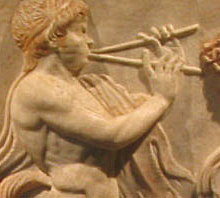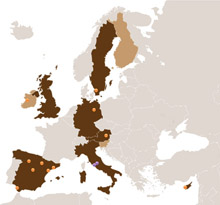2nd meeting of the Auloi/Tibiae Team of the European Music Archaeology Project
- Dettagli
- Categoria principale: OltreNews PressAgency
- Categoria: Musica
- Pubblicato Mercoledì, 08 Ottobre 2014 18:49
- Scritto da Redazione
- Visite: 9719

The second meeting of The Workshop of Dionysus will bring together again in Tarquinia the same EMAP team of specialists who are investigating and reconstructing the instrument that the Greeks called aulos, the Romans called tibia and the Etruscans probably called suplu. The latest results of this research will be presented by the EMAP team on the last day of the workshop, in a public event at the Auditorium of the Santa Maria in Gradi historical complex in Viterbo.
 The Workshop of Dionysus (WoD) is a team of researchers, musicians and artisans working on the revival of ancient double pipes (aulos in Greek / tibia in Latin) within the European Music Archaeology Project (EMAP). Core team members are: Stefan Hagel (Austrian Academy of Science); Olga Sutkowska (Berlin University of the Arts); Barnaby Brown (University of Cambridge); Cristina Majnero and Roberto Stanco (Ludi Scænici); Peter Holmes, Martin Sims and Neil 'Spike' Melton (Middlesex University); and Thomas Rezanka and Marco Sciascia (independent artisans). The WoD meetings are supervised by Emiliano Li Castro (EMAP's artistic director) and facilitated by Adje Both (EMAP's exhibition curator).
The Workshop of Dionysus (WoD) is a team of researchers, musicians and artisans working on the revival of ancient double pipes (aulos in Greek / tibia in Latin) within the European Music Archaeology Project (EMAP). Core team members are: Stefan Hagel (Austrian Academy of Science); Olga Sutkowska (Berlin University of the Arts); Barnaby Brown (University of Cambridge); Cristina Majnero and Roberto Stanco (Ludi Scænici); Peter Holmes, Martin Sims and Neil 'Spike' Melton (Middlesex University); and Thomas Rezanka and Marco Sciascia (independent artisans). The WoD meetings are supervised by Emiliano Li Castro (EMAP's artistic director) and facilitated by Adje Both (EMAP's exhibition curator).
The main focus of our 2nd meeting is to explore practical aspects of playing ancient double pipes, fertilized on the one hand by ancient evidence and on the other by living piping traditions. Scholars, musicians and anyone working in the auloi/tibiae field are invited to join us in reviving one of ancient Europe's most prominent instruments. The meeting will conclude with a concert given by all participants at the EMAP's general meeting in Viterbo.
Il Laboratorio di Dioniso torna a Tarquinia per il secondo meeting dell'Auloi/Tibiae Revival Project, un programma scientifico e artistico finalizzato alla ricostruzione, allo studio, alla rinnovata pratica di un aerofono che viene spesso definito "doppio flauto" – sebbene l'ancia ne faccia piuttosto un progenitore dell'oboe – estremamente diffuso, considerato, apprezzato nell'antichità sulle sponde del Mediterraneo e oltre.
In questo secondo appuntamento "dionisiaco" inserito nel "cartellone" dell'EMAP (European Music Archeology Project), il team di ricercatori scientifici, musicisti e artigiani che potendo contare su analisi e riproduzioni di alto livello sta portando avanti sulla materia le indagini più approfondite di sempre, proverà ad intrecciare le risultanze archeologiche con quel che ancora oggi, in diverse tradizioni musicali (è il caso ad esempio delle launeddas sarde) rimanda direttamente allo strumento così come lo conoscevano i Greci (aulos) e i Romani (tibia).
Del risultato "sonoro" si potrà godere in più occasioni: durante le prove aperte al pubblico nei saloni del Comune di Tarquinia (12 ottobre, ore 18,30), nell'incontro con le scuole di Tarquinia a cui daranno vita Roberto Stanco e Cristina Majnero dell'ensemble Ludi Scaenici il 15 ottobre e soprattutto nel concerto finale che verrà ospitato dall'Università della Tuscia a Viterbo, alle 19 dello stesso giorno, presso l'Auditorium del complesso storico di S. Maria in Gradi.
La performance inaugura idealmente il quinto General Meeting dell'EMAP, che riunirà proprio a Viterbo dal 15 al 17 ottobre i rappresentanti delle dieci istituzioni europee coinvolte nelle attività di ricerca e divulgazione - laboratori, pubblicazioni, concerti, programmi didattici, la mostra itinerante e interattiva Archaeomusica: Exploring the Sounds and Music of Ancient Europe – in cui si articola il progetto.
Fonte: EMAP (European Music Archeology Project)
